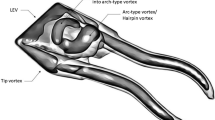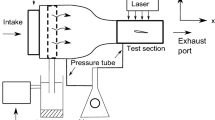Abstract
The impact of Gurney flaps, of different heights and perforations, on the growth and development of a tip vortex, both along the tip and in the near field of a finite NACA 0012 wing, at Re = 1.05 × 105 was investigated by using particle image velocimetry (PIV). Wind-tunnel force balance measurements were also made to supplement the PIV results. This study is a continuation of the work of Lee and Ko (Exp Fluids 46(6):1005–1019, 2009) on the near-wake measurements behind perforated Gurney flaps. The present results show that along the tip, the overall behavior of the secondary vortices and their interaction with the primary, or tip, vortex remained basically unchanged, regardless of flap height and perforation. The peak vorticity of the tip vortex, however, increased with flap height and always exhibited a local maximum at x/c = 0.8 (from the leading edge). In the near field, the strength and structure of the near-field tip vortex were found to vary greatly with the flap height and perforation. The small flaps produced a more concentrated tip vortex with an increased circulation, while the large Gurney flaps caused a disruption of the tip vortex. The disrupted vortex can, however, be re-established by the addition of flap perforation. The larger the flap perforation the more organized the tip vortex. The Gurney flaps have the potential to serve as an alternative off-design wake vortex control device.









Similar content being viewed by others
Abbreviations
- AR :
-
Aspect ratio = (2b)2/S
- b :
-
Semi span
- c :
-
Chord
- C D :
-
Total drag coefficient
- C L :
-
Total lift coefficient
- C L,max :
-
Maximum lift coefficient
- d :
-
Hole diameter
- h :
-
Flap height
- r :
-
Radius from vortex center
- r c :
-
Core radius
- Re :
-
Chord Reynolds number = u ∞ c/ν
- S :
-
Total wing surface area
- u :
-
Mean axial velocity
- u c :
-
Mean core axial velocity
- u ∞ :
-
Freestream velocity
- x,y,z :
-
Streamwise, normal and spanwise direction
- α :
-
Angle of attack
- α ss :
-
Static-stall angle
- σ :
-
Perforation
- Γ:
-
Circulation
- Γc :
-
Core circulation
- v θ :
-
Tangential velocity
- vθ,peak:
-
Peak tangential velocity
- ζ:
-
Vorticity
- ζpeak :
-
Peak vorticity
- ν :
-
Kinematic viscosity
References
Gerontakos P, Lee T (2006) Near-field tip vortex behind a swept wing model. Exp Fluids 40:141–155
Gerontakos P, Lee T (2008) PIV investigation of flow over unsteady airfoil with trailing-edge strip. Exp Fluids 44(4):539–556
Hoffman E, Joubert P (1963) Turbulent line vortices. J Fluid Mech 16:395–411
Jeffrey D, Zhang X, Hurst DW (2000) Aerodynamics of Gurney flaps on a single-element high-lift wing. J Aircr 37(2):295–301
Lamb H (1945) Hydrodynamics, 6th edn. Dover, New York
Lee T, Ko LS (2009) PIV investigation of flowfield behind perforated Gurney-type flaps. Exp Fluids 46(6):1005–1019
Liebeck RH (1978) Design of subsonic airfoils for high lift. J Aircr 15(9):547–561
Meyer R, Hage W, Bechert DW, Schatz M, Thiele F (2006) Drag reduction on Gurney flap by three-dimensional modifications. J Aircr 43(1):132–140
Myose R, Papadakis M, Heron I (1998) Gurney flap experiments on airfoils, wings, and reflection plane model. J Aircr 35(2):206–211
Neuhart DH, Pendergraft OC (1988) A water tunnel study of Gurney flaps. NASA TM 4071
Nikolic VR (2006) Trailing vortex rollup from a wing equipped with a Gurney flap. J Aircr 43(2):569–571
Phillips WRC (1981) The turbulent trailing vortex during roll-up. J Fluid Mech 105:451–467
Shekarriz TC, Fu TC, Katz J, Liu HL, Huang TT (1992) Study of junction and tip vortices using particle image velocimetry. AIAA J 30(1):145–152
Stanewsky E (2001) Adaptive wing and flow control technology. Prog Aerosp Sci 37:583–667
Storms BL, Jang CS (1994) Lift enhancement of an airfoil using a Gurney flap and vortex generators. J Aircr 31(3):542–547
Troolin DR (2009) Private communication. dtroolin@tsi.com
Wang JJ, Li YC, Choi K-S (2008) Gurney flap-lift enhancement, mechanism and applications. Prog Aerosp 44:22–47
Yeung AFk, Lee BHK (1999) Particle image velocimetry study of wing-tip vortices. AIAA J 36(2):482–484
Zerihan J, Zhang X (2001) Aerodynamics of Gurney flaps on a wing in ground effect. AIAA J 39(5):772–780
Zhang W, Wang JJ, Wu Z (2006a) Experimental investigation on the application of lift enhancement devices to forward-swept aircraft model. Aeronaut J 110:361–367
Zhang HJ, Zhou Y, Whitelaw JH (2006b) Near field wing-tip vortices and exponential vortex solution. J Aircr 43(2):445–449
Acknowledgments
This work was supported by the Natural Science and Engineering Research Council (NSERC) of Canada. L.S. Ko is thanked for his help with the experiment.
Author information
Authors and Affiliations
Corresponding author
Rights and permissions
About this article
Cite this article
Lee, T. PIV study of near-field tip vortex behind perforated Gurney flaps. Exp Fluids 50, 351–361 (2011). https://doi.org/10.1007/s00348-010-0933-x
Received:
Revised:
Accepted:
Published:
Issue Date:
DOI: https://doi.org/10.1007/s00348-010-0933-x




